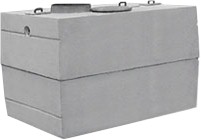 If you have a septic system then you already know you have a septic tank. But what is a septic tank and what does it do?
If you have a septic system then you already know you have a septic tank. But what is a septic tank and what does it do?
Here’s a brief review of the septic tank. Of course the septic tank is just one component of an entire septic system. There’s also piping, drainfield, typically a pump or aerator, and other accessories. But let’s just look at the septic tank to see what it does exactly.
First, all of your household wastewater exits your home through a pipe connected to your home’s plumbing system and flows into the septic tank. The septic tank is a buried watertight container and is typically made of concrete, fiberglass, or polyethylene. The tank holds the wastewater long enough to allow solids to settle out forming a sludge layer at the bottom of the tank. The solid waste is digested in the tank by aerobic and/or anaerobic bacteria. You can read more about this process here: Anaerobic vs Aerobic Bacteria. Oil and grease float to the surface as a scum layer.
Compartments and a T-shaped outlet in the septic tank prevent the sludge and scum from leaving the tank and traveling into the drainfield area but if allowed to buildup can cause problems that prevent the septic system from performing properly.
To prevent excessive buildup, sludge and floating scum need to be removed through periodic pumping of the septic tank. Regular inspections and pumping as necessary (generally every 3 to 5 years) are the best and cheapest way to keep your septic system in good working order.




 2016
2016 2016
2016














